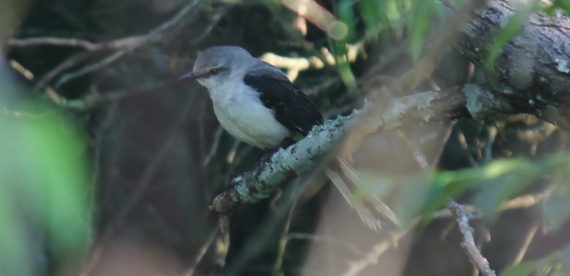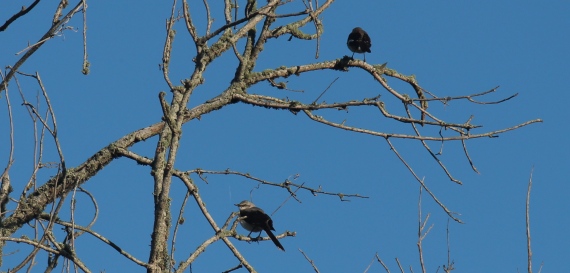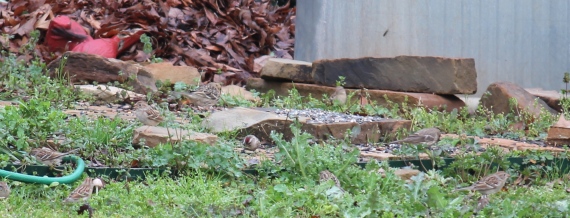I included a brief article below that I wrote for the Houston Ornithological Group’s newsletter, the Spoonbill. First I will relate an additional Juniper Titmouse observation during Spring Break in the Guadalupe Mountains National Park.
After failing to find a Juniper Titmouse at Dog Canyon, even though I had potentially heard one, we tested our luck at Frijole Ranch on the eastern side of the Guadalupe Mountains National Park. Arriving in the early afternoon didn’t bode well as bird activity was low during the hot afternoon. We passed the old ranch house and continued along the paved trail, focusing our efforts on the dense junipers near the spring where I had found a single bird in August (see article below). Flocks of robins flushed and several Townsend’s Solitaires were in evidence, but no a feather or sound of a titmouse. We hiked the entire trail, mainly because we were already here, finding almost no birds. Returning to the ranch from where we had started we planned to check the larger juniper on the southern side of the parking lot when we heard a bird that sounded decidedly different from everything that day. Somewhat in disbelief we realized that this was our bird. We rushed forward and quickly located it in one of the tall pecans. I was surprised as the bird flew into the highest exposed parts of the pecan trees foraging and singing. We watched it for nearly twenty minutes as it sang and foraged. It spent a lot of time in the pecans, flying off twice into nearby dense junipers. Eventually it flew off to forage in a dense thicket right along the fence and landed out in the open on the ground twice.
It disappeared towards dense junipers on the eastern side of the ranch. During the entire observation the bird was very vocal and foraged actively. It was interesting to see it check the underside of the withered pecan leaves, apparently picking off small insects. There was no sign of another bird and this may have been the same single bird I had observed in August as my observation had been within 300 meters. Potentially Juniper Titmice in Texas require relatively dense junipers with scattered large trees, which may limit the distribution of the species even in good looking habitat. Distribution and range may be limited in the area by available nest sites? Either way we were happy to observe this low density species again in Texas.
A Tricky Bird: Finding Juniper Titmouse in Texas
By Stephan Lorenz
The Juniper Titmouse (Baeolophus ridgwayi) has a very restricted range within Texas and is essentially limited to the foothills of the Guadalupe Mountains, Culberson County, where it is an uncommon resident. It is arguably one of the most difficult resident or regularly occurring bird’s to see in Texas, with Spotted Owl, Hook-billed Kite, Red Crossbill, and Cassin’s Finch also in the running for toughest non-review species. Juniper Titmouse is a common species throughout many areas of the southwestern United States, including New Mexico just across the state line. Yet, just to the south in Texas, birds are thin on the ground and are regularly reported from only two places within the lower elevations of the Guadalupe Mountains, Dog Canyon and Frijole Ranch. The species has been sighted in the El Paso area, but the national park remains by far the best location to add this little drab Parid to your Texas state list.
I had attempted to see Juniper Titmice in the Guadalupe Mountains on several previous occasions in the past seven years. On each visit to the Guadalupes, I set aside a little time to wander in the juniper woodlands and foothills, hoping to come across the birds. I even made a concerted effort during the summer of 2005, when I took the long route through New Mexico into Dog Canyon. Despite long hikes and chasing after everything that even remotely sounded like a titmouse, I always came up empty or with plenty of Rock Wrens. I know that several Texas birders can commiserate with similar experiences.
Overall, the single best place remains Dog Canyon, which lies at the end of State Road 137, a long winding gravel track that meanders south after turning off Highway 285 just north of Carlsbad, New Mexico. This is not a casual trip and it is best to take advantage of the beautiful and isolated campground at Dog Canyon, packing gear for a night or two. Keep in mind, Juniper Titmice are not guaranteed here, but plenty of scenery and other birds are. Once the road crosses back into Texas start looking for titmice in the juniper woodlands.
During my recent visit to the area, I didn’t have time to visit remote Dog Canyon and decided to give the alternative location a try, Frijole Ranch. The historic ranch is located just off Highway 62 and offers easy access to foothill habitat and several productive springs. When I pulled into the gravel parking lot, the weather looked ominous. Afternoon thunderstorms are not uncommon during late August. Black clouds were tumbling over gray and I could see dark streaks of rain falling in the high country. I grabbed my binoculars, camera, and rain jacket, hoping to catch a few minutes of birding. Just past the ranch house starts a trail leading to Frijole Springs and beyond, the sparse juniper woodland here is probably the best place to look for titmice. First, I was greeted by Scott’s Orioles and Western Tanagers, adding color to the Chihuahuan desert. A Gray Flycatcher flitting between ocotillo sported titmouse colors, but was the wrong family.
When I heard a bird just a minute later, I almost didn’t trust my ears. I walked off the trail towards a dense stand of junipers. Several sparrows flew off the ground and then it called again. It fluttered between trees and the complete lack of color gave it away, finally there was a Juniper Titmouse on Texas soil. I followed the bird several minutes as it foraged relatively quickly, moving from tree to tree. When it was quiet it was difficult to keep track off. During the entire observation there was no sound or sight of a second bird, just a single Juniper Titmouse. After it disappeared, I took a long look at the surroundings and could see similar stands of juniper stretch from the foothills to the north, east, and south. It looked like there was an abundance of suitable habitat and why the species occurs in such low densities in Texas is a mystery to me, but all it takes is one.











